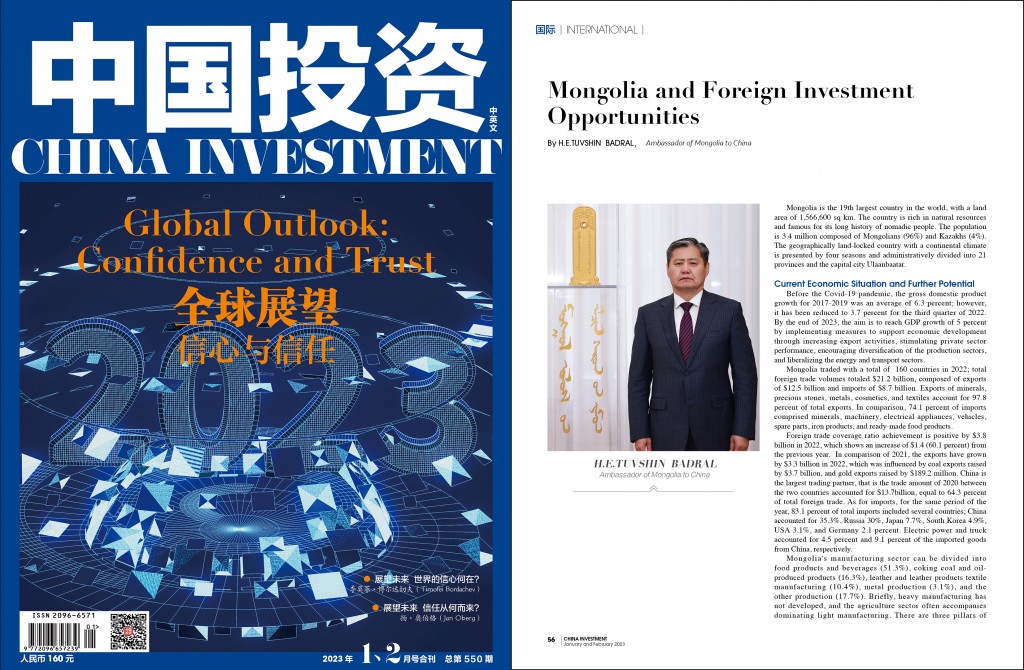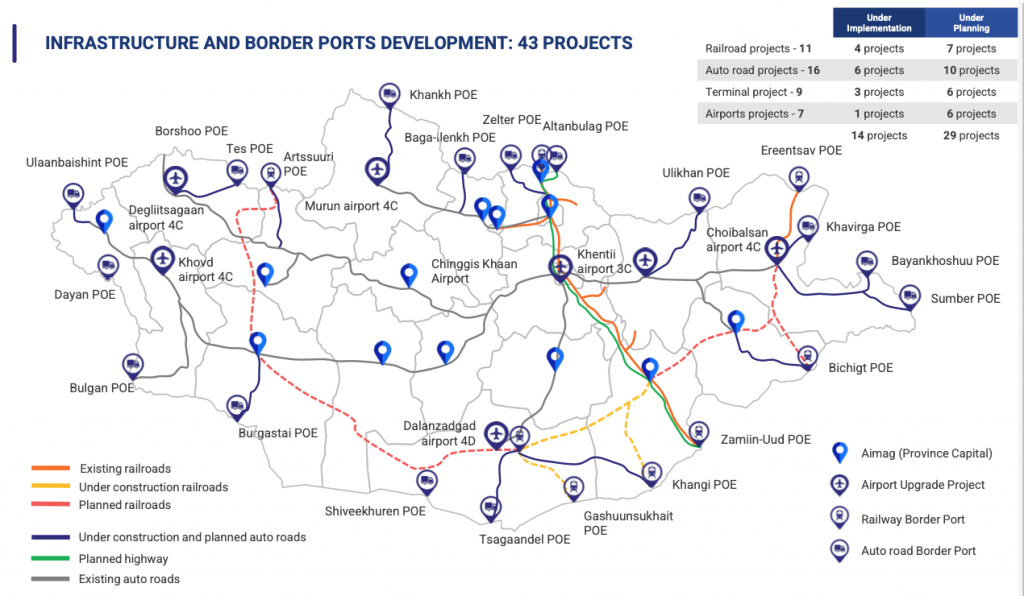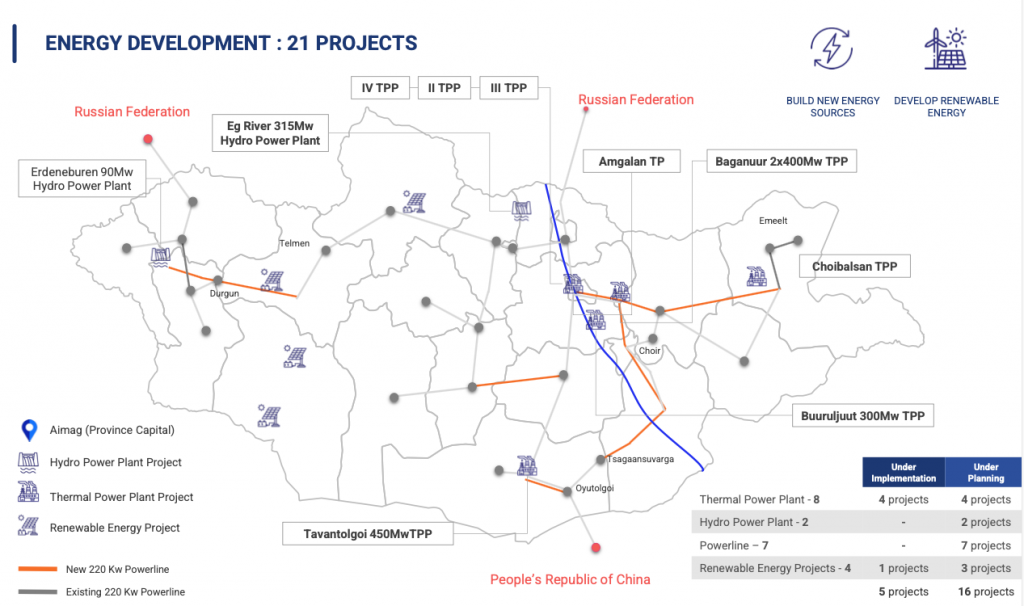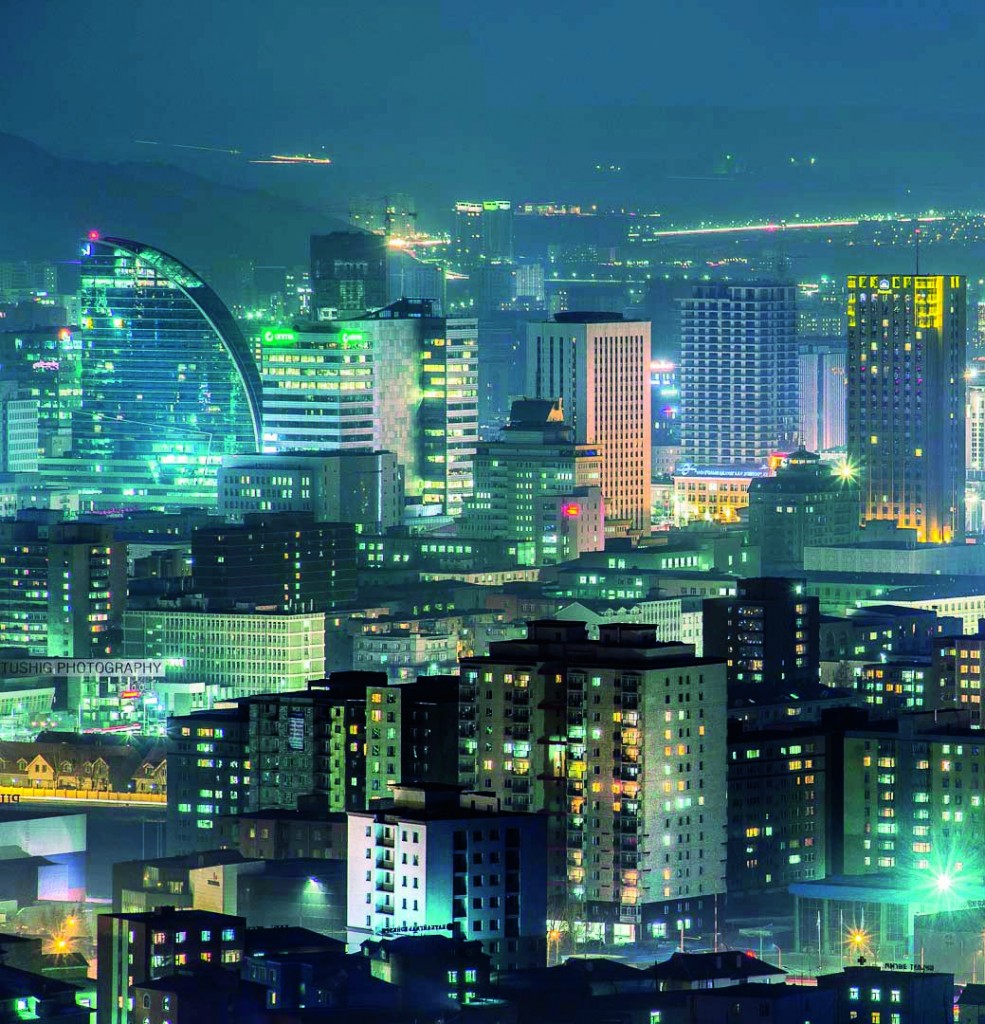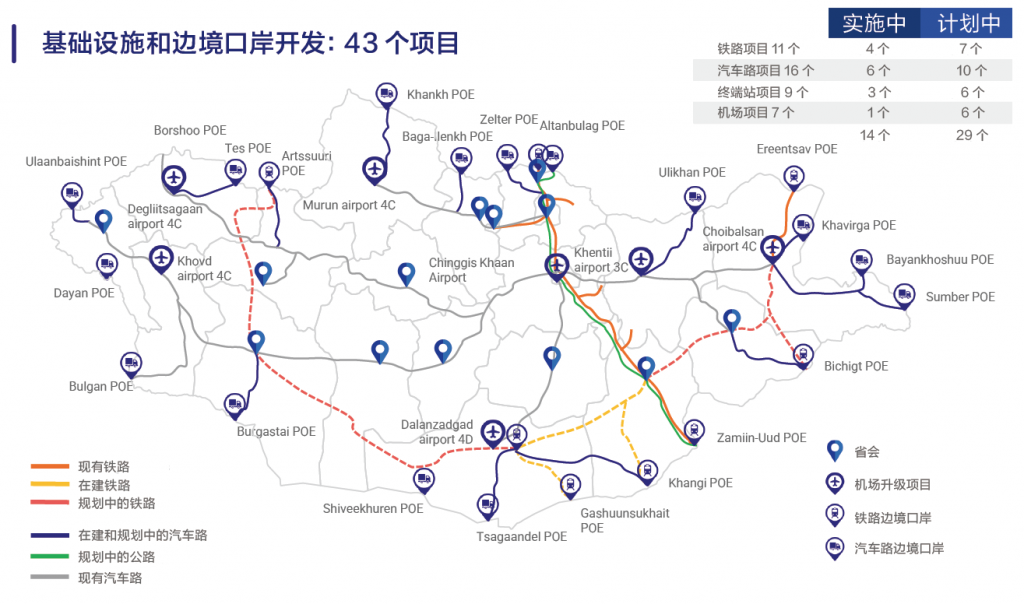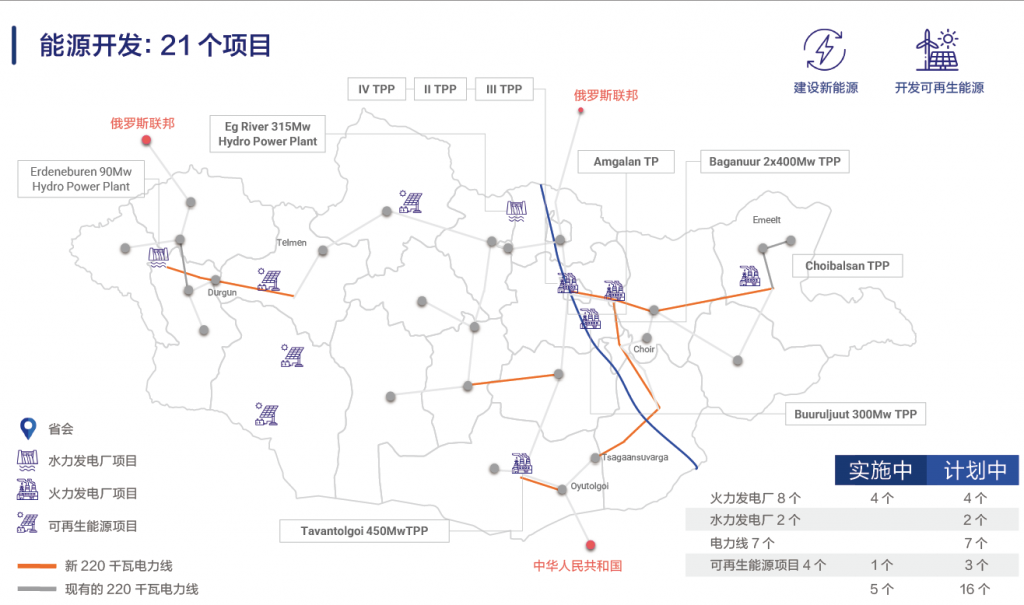By H.E.TUVSHIN BADRAL, Ambassador of Mongolia to China
文|图布辛·巴德尔勒(TUVSHIN BADRAL) 蒙古国驻华大使 翻译|王晓波 图表提供|蒙古国驻华大使馆
导读
●当前的经济形势和未来的潜力
●目标和挑战
●未来和机遇
Mongolia is the 19th largest country in the world, with a land area of 1,566,600 sq km. The country is rich in natural resources and famous for its long history of nomadic people. The population is 3.4 million composed of Mongolians (96%) and Kazakhs (4%). The geographically land-locked country with a continental climate is presented by four seasons and administratively divided into 21 provinces and the capital city Ulaanbaatar.
Current Economic Situation and Further Potential
Before the Covid-19 pandemic, the gross domestic product growth for 2017-2019 was an average of 6.3 percent; however, it has been reduced to 3.7 percent for the third quarter of 2022. By the end of 2023, the aim is to reach GDP growth of 5 percent by implementing measures to support economic development through increasing export activities, stimulating private sector performance, encouraging diversification of the production sectors, and liberalizing the energy and transport sectors.
Mongolia traded with a total of 160 countries in 2022; total foreign trade volumes totaled $21.2 billion, composed of exports of $12.5 billion and imports of $8.7 billion. Exports of minerals, precious stones, metals, cosmetics, and textiles account for 97.8 percent of total exports. In comparison, 74.1 percent of imports comprised minerals, machinery, electrical appliances, vehicles, spare parts, iron products, and ready-made food products.
Foreign trade coverage ratio achievement is positive by $3.8 billion in 2022, which shows an increase of $1.4 (60.1 percent) from the previous year. In comparison of 2021, the exports have grown by $3.3 billion in 2022, which was influenced by coal exports raised by $3.7 billion, and gold exports raised by $189.2 million. China is the largest trading partner, that is the trade amount of 2020 between the two countries accounted for $13.7billion, equal to 64.3 percent of total foreign trade. As for imports, for the same period of the year, 83.1 percent of total imports included several countries; China accounted for 35.3%, Russia 30%, Japan 7.7%, South Korea 4.9%, USA 3.1%, and Germany 2.1 percent. Electric power and truck accounted for 4.5 percent and 9.1 percent of the imported goods from China, respectively.
Mongolia’s manufacturing sector can be divided into food products and beverages (51.3%), coking coal and oil-produced products (16.3%), leather and leather products textile manufacturing (10.4%), metal production (3.1%), and the other production (17.7%). Briefly, heavy manufacturing has not developed, and the agriculture sector often accompanies dominating light manufacturing. There are three pillars of Mongolia’s economy: agriculture, tourism, and mining.
Agriculture is central to the economic development of our country, and manufactured products are used as commodities for population consumption and raw material processing. By the end of 2021, .Mongolia had 67 million livestock, dominated by larger proportions of the sheep and goats. Altogether, 678,000 acres of land are cultivated, 63.7 percent of which is dedicated to grains, wheat, and the remaining area for vegetables. The amount of land used in agriculture accounts for 0.43% of the total land area, indicating that the sector has a huge space for further development. Agriculture makes up 30% of the total gross domestic product, and the sector’s export income makes up 8.3% of total exports.
The tourism industry had been developing rapidly before the Covid-19 pandemic. Many things, such as our country’s natural, cultural, and historical heritage, are of great interest to the world. Statistics from 2019 show that the number of foreign tourists visiting Mongolia reached more than 300,000. In May 2022, Mongolia announced the opening of the border and invited tourists from all over the world. The Government of Mongolia declared the years between 2023-2025 as the “Year of Visiting Mongolia” to restore all forms of tourism. In addition to reforming the legal and policy environment, many activities are planned in such areas as improving standards for tourism activities, easing electronic money transfer, and air traffic liberalization. There is an excellent opportunity to develop tourism around the border.
The mining industry is a key pillar of Mongolia’s economy, and its export-oriented mining products include coal, iron ore, copper, copper concentrate, gold, fluorspar, zinc, and oil. Trade with China amounted to $10.1 billion in 2021 and $10 billion in the ten months of 2022, representing 64.1 percent of total foreign trade. Coal accounts for 55.3% and 27.6% of copper concentrates of all goods exported to China. The volume of crude exports reached to 4.1 million tonnes in October 2022, which is down 69.3 thousand tons from the previous month, and its price was US $608.3 million, which is reduced by $15.1 million.
Since 1990, in a total of $37.9 billion has been invested to the country as direct foreign investment, of which $2.7 billion was provided in 2021. Overall, 70 percent of the investment goes into geology and mining, followed by wholesale and retail (17 percent) trade. When direct investment is analyzed by country, China accounts for 18 percent of the total. We are working on legal and policy reforms to improve the environment of foreign investment, protection of the investors, establishment of a responsible organization and support specific sectors. Amendments have been made to the Laws on “Public and Private Partnership” and “Permission” to improve the business environment. It also plans to make further amendments soon to the Law on Foreign Investment to clarify the rights and duties of investors, to protect them and to create a mutually beneficial working environment. Activities are also being implemented to support investment, including the establishment of a Council to Protect Investor Benefits, the establishment of a system for regular operations, the operation of a digital system that receives and handles complaints from parties.
Goals and challenges
The Parliament of Mongolia approved a policy document entitled “Vision 2050” in May 2020, which was developed based on the fundamental principles of improving economic innovation, promoting leading sectors, achieving successive export growth, and stabilizing additional cost-effective manufacturing policies over a long period.
The aim of the policy is to build up the multi-faceted economy with the ability of meeting its own internal needs, accelerate exports, has built its investment and savings capabilities through the creation of a fundamental policy framework for economic development to increase the volume of the middle class, reduce poverty and sustainable economic growth experienced by every citizen.
Phase I of this policy is directed at developing leading sectors of the economy, creating an export-driven economy, initiating structural reforms in the economy, increasing competitiveness, replacing imports, and developing heavy and light industries aimed at exports.
Several objectives were put forward within the policy, including development of accountable mining, increased levels of processing steps in the manufacturing of the agricultural and mining products, rise the export of livestock driven products, development of national-specific tourism, enhancing the ability of the tourism to compete in the international tourism market, expanding power plants, building power transmission lines, substations and new sources, and meeting the internal needs of electricity, and developing national transportation and logistics systems. Additionally, the intense effort has been dedicated to joining the regional economic and trade integration, enhancing foreign economic relations, facilitating trade, developing Mongolia-Russia-China’s economic corridor, and establishing a “Free Trade Agreement” with China and Russia.
In December 2021, the “New Recovery Policy” was approved to implement the above-mentioned policy documents, with six main goals: port, energy, manufacturing, green development, urban development, and the restoration of public sector productivity. A total of 94 projects and programs have been put forward for implementation within this policy framework, with an estimated cost of $24.6 billion. Of these projects and programs, 25 are in the implementation period, while 69 are in the process of being developed. There are 32 projects and programs that can be funded by foreign direct investment, and they require a budget of $11.04 billion. Consider separately since most of the 94 projects and programs will be implemented in ports (43), energy (21), and industrial (16) restoration.
Port recovery.
The border length between Mongolia and China is 4706.9 kilometers long with 17 land ports. The main document of the border-related regulation is the Agreement on the border ports and management between the Governments of Mongolia and China, which was updated last time in 2004. Within the framework of the recovery of the port, the projects are being implemented: railways (11), roads (16), airports (7), and port terminals (9).
Within the framework of the policy, the projects will be implemented to connect port terminals by railways, including Zamiin uud-Erlian, Gashuunsukhait- Gants mod, Bichigt-Zuun khatavch, and Hangi-Mandal and establish the port terminals at those areas. Moreover, the intensive projects will be implemented in improving the air road management and air traffic utilization, building the capacity of the air transport in terms of airship quantity and airports, supporting air cargo anchor hubs and liberalization of air transportation, and contributing to the tourism expansion.
Those will increase the capacity and flow of the cargo and passenger movement and improve export and trade volumes. The establishment of free trade and economic zones and land ports, according to the phase plans, will enhance the competitiveness of transportation and logistics and create a foundation for further development as the “Transit Country.”
Within the past three years, we have built more than 800 kilometers of long railways to the ports, followed by the negotiating steps of connecting the Ghashuun suhait-Gants Mod and Hangi-Mandal ports with China’s side. Furthermore, construction work is planned to begin on the building of the railways for the two ports linking the Shivee khuren-Tsekhee and the Bichigt-Zuun khatavch, as well as the renovation of the central railway lines, and the construction of the western and eastern railway lines. As a result of those constructions, the port access capacity will be raised by three times, the national railway network length will be doubled, and the 2,966 km road linking the port will be built. The number of active airports will be doubled, and 4C ranking airports will be reached to four.
Energy recovery.
The development of renewable energy is one of the main goals with the purposes of fully utilizing renewable energy resources and supporting the use of green energy. It is planned to develop renewable energy in a reasonable quantity by building water and solar, wind accumulation stations and ensuring the reliability and stability of the integrated energy system. This policy framework includes projects of establishing and renovating two water, seven renewable power plants, and eight heat power plants. Foreign investment for these energy projects is open to international partners.
The energy sector aims to develop an independent financial and economic system step by step and encourage green development through foreign partners’ joint collaboration and investment in building renewable power plants and other energy projects. Enabling the export of the produced energy to China is seen as the creation of new content for bilateral cooperation and economic development. Moreover, the joint project plan has been completed, and construction work is going to commence to establish the natural gas pipeline from Russia to China through Mongolia.
Manufacturing recovery.
It is planned to establish the heavy (13) and lightweight (3) manufacturers step by step to produce value-added products. Full digitalization of the special permit provision process for mining procedures, support the technologies to reduce the production costs and increase foreign investment, and encouraging enrichment of the mineral warranty reserves through new product development resulted in the application of the advanced technique and technology are included in the plan. Special attention is directed to the production of heavy industrial products for the full supply of the country’s domestic needs and increased exports. We are focusing on the issue of supplying raw materials to the domestic oil processing industry by raising the warranty reserves of crude oil and increasing drilling.
Agricultural production will be developed based on advanced technology and innovation and will increase the volume of new products, services, and production. Expanding the capacity of the processing manufacturers in conjunction with the supply of agricultural raw materials and products, it will increase the export of value-added final products by reducing the high quantity of semi-processed products exports. The agricultural production sector will introduce high-tech, blockchain, and artificial intelligence breakthroughs based on science and develop industries that meet digital economic trends.
In phase I of the “New Recovery Policy,” industrial and technological parks (2), mining processing plants (9), oil processing plants (2), meat product factories and livestock disease-free zones (2-4), and leather processing (1) plant are planned. As a result, total exports are expected to increase by $30 billion, the share of the processing industry in GDP by 15%, the level of leather processing by 60% and the domestic supply of fuel by 55%. It is hoped that further mining-oriented cooperation and investment will be in the direction of value-added product development using natural resources such as coal, coal chemical and mining products processing.
The above-mentioned three goals of the New Recovery Policy are essential in the expansion of the country’s foreign trade, investment, and cooperation and other realistic possibilities of further collaboration is discussed further.
The future and the opportunity
Economic Cooperation and Free Trade Zone of Zamiin uud and Erlian
This economic cooperation zone is vital for developing bilateral relations and cooperation in a new phase between the two countries. The benefits of the zone are numerous, including establishing trade and economic corridors with two neighboring countries, developing transit transportation, exporting value-added products, thereby expanding cooperation with EU countries, and intensifying tourism. Following the zone establishment, there will be an increase in employment, and new advanced technologies will be applied within the production lines. Moreover, the Agreements signed by the Governments of the two countries will have a favorable environment of implementation.
Currently, 66 companies have acquired the land to conduct business in the zone, and seven of them have begun to build the facilities. The Zone Administrative Office is working step by step to increase the capacity of the infrastructure station, create a comfortable condition for investors, support the project with sustainable management, and establish a port system for access to the free zone. In the third and fourth sections of the Zone, the facilities have been built for supplies of power, water, wastewater treatment, communication, heating, and the roads in the area. The power plant has the capacity of providing electricity to the Zone as well as Zamiin uud when it becomes fully operational.
Operation of the zone will ease the tariffs and non-tariff barriers in foreign trade, which will attract international companies and Chinese manufacturing entities to leverage its favorable environment to reduce the production cost. Today, worldwide, reducing cost of human resource and production materials and inputs are making changes in the global economic hub and region, international labor schedules, the financial and business structure of countries, and the labor market. It is crucial for our country to be joined into the global trading network, to develop e-commerce, and to trade with products that met international standards. The Zone will work as an essential part in achieving the success as mentioned above not only for Mongolia but also for other investors and manufacturers.
The President’s Visit Endorsed the Project and Programmes
President of Mongolia, Khurelsukh Ukhnaa made the state visit to China on November 27-28, 2022. During the visit, Mongolia and the Republic of China issued a joint statement on the further development of full strategic partnerships, which aims to transform the friendly political relations into a framework of cooperation, and agreed to expand cooperation in trade, investment, finance, mining, energy, infrastructure, digital economy, and green development. Some of the important points are below:
• Mongolia and China agreed to continue good political relations as a driving force for cooperation, to take advantage of the geographical location and economic cooperation of the two countries, and to expand mutually beneficial cooperation for the good of the people of the two countries. In this framework, the national-level projects and programs should be implemented within the integration to achieve a successful outcome, including “Step Road” project in line with “Road and Belt” initiative, the “New Recovery Policy” with the “Global Development Initiative” and the long-term development policy “Vision 2050” with the strategic objectives of the “Two Steps” development strategy.
• Mongolia and China agreed to reach the foreign trade volume to $20 billion in the near future. China is an eternal neighbor to Mongolia and the largest trade partner. Foreign trade flows between the two countries have increased 240-fold over the past 31 years, surpassing $10 billion by December 2021. That figure was at $5 billion just four years ago.
• A new investment agreement on investment and development has been approved by the Governments of two countries. As a result, the two countries are experiencing a new era of economic relations.
• The Chinese side supported Mongolia’s proposal to increase the coal export to 40-70 million tons a year. Exports of 31 million tonnes of coal in 2019 were the highest ever.
• Construction of infrastructure, railways, and roads through the interconnected countries’ borders and opening a new railway line linking Mongolia and China in the near future are supported by the Governments of two countries. It was agreed to accelerate links to export railways such as Tavantolgoi-Gashuunsukhait and Zuunbayan-Hangi, which are ready to connect from Mongolia. It has also agreed to promote the projects and activities to introduce new cargo techniques and technologies at border ports and to increase port capacity realistically and efficiently.
• As part of reducing Ulaanbaatar’s traffic complications, underground bridge projects will be funded through voluntary assistance from China. Building a bridge facility in four locations in Ulaanbaatar.
• The joint statement noted that Chinese side officially confirmed the purchase of natural gas from Russia through the pipeline, which will be built through Mongolia.
• The Chinese side will continue to support Mongolia in easing the landlocked position and transportation of the imports, which are essential to the supply of the domestic need of the people.
Economic development and the foreign trade environment is becoming promising, supportive, and open for all the stakeholders; therefore, I would like to invite Chinese investors to take part in the joint journey of the future.
Mongolia and China are eternal neighbors and best partners. During the early period of the pandemic, Mongolians were donating sheep to the Chinese people, while the Chinese Government donated vaccines, medical equipment, and tea to Mongolia during the infection waves. It is an example of the mutual relation and cooperation between two countries named as “tea in return for the sheep.” We are confident that the two countries will work together, develop together, jointly expand mutually beneficial and mutually complementation cooperation, and enrich a new page of history over the coming century with the content of many collaborations.
蒙古国(编者注:蒙古国简称蒙古)是世界第19大国家,国土面积156.66万平方公里。蒙古自然资源丰富,并以其游牧民族的悠久历史而闻名。蒙古有人口340万,由蒙古人(96%)和哈萨克族(4%)组成。蒙古作为地理上的内陆国家属于大陆性气候,一年有四个季节。行政上分为21个省,首都是乌兰巴托。
当前的经济形势和未来的潜力
新冠疫情暴发前,2017-2019年的国内生产总值的平均增长为6.3%,2022年第三季度,这一比例降至3.7%。到2023年末,蒙古政府的目标是通过采取措施,增加出口,提升私营部门的业绩,鼓励生产行业的多样化生产以及开放能源和运输领域来促进经济发展,从而实现GDP增长达到5%。
2022年,蒙古与160个国家有贸易往来,外贸总额为212亿美元,其中出口125亿美元,进口87亿美元。矿物、宝石、金属、化妆品和纺织品的出口占到出口总额的97.8%。另一方面,74.1%的进口则包括矿产、机械、电器、车辆、零备件、铁制品和现成食品。
2022年,进出口贸易实现了38亿美元的正增长,比上一年增长了14亿美元(增幅达60.1%)。与2021年相比,2022年的出口增长了33亿美元,这是受煤炭出口37亿美元和黄金出口1.892亿美元的影响。中国是蒙古最大的贸易伙伴,2020年两国之间的贸易额为137亿美元,占蒙古对外贸易总额的64.3%。在进口方面,2020年进口总值中的83.1%来自这几个国家:中国占35.3%、俄罗斯占30%、日本占7.7%、韩国占4.9%、美国占3.1%、德国占2.1%。电力和卡车分别占从中国进口货物的4.5%和9.1%。
蒙古的制造业可分为食品和饮料(51.3%)、炼焦煤和石油产品(16.3%)、皮革和皮革制品的纺织制造(10.4%)、金属生产(3.1%)以及其他生产(17.7%)。简言之,蒙古的重型制造业尚未发展起来,农业领域往往是轻型制造业占主导。蒙古经济的三大支柱是:农业、旅游业和采矿业。
农业是蒙古经济发展的中心,而其制成品则被用作人民消费和原材料加工的商品。截至2021年底,蒙古有6700万头牲畜,其中大部分是绵羊和山羊。蒙古共有678000英亩的可耕种土地,其中63.7%的土地被用于种植谷物和小麦,其余的则用于种植蔬菜。农业用地仅占土地总面积的0.43%,这表明它有着巨大的发展空间。农业占国内生产总值的30%,该领域的出口收入占出口总额的8.3%。
在新冠疫情暴发前,蒙古的旅游业一直在快速发展。蒙古的许多方面,比如其自然、文化和历史遗产,都令世界感兴趣。2019年的统计数据显示,到访蒙古的外国游客人数已达到30多万。2022年5月,蒙古宣布开放边境,并邀请来自世界各地的游客。蒙古政府宣布2023-2025年为“游览蒙古年”,意在恢复所有形式的旅游业。除了改革法律和政策环境外,政府还计划在提高旅游活动标准、简化电子转账程序,和空中交通自由化等方面采取更多措施。这些都是开发边境旅游业的绝佳机会。
采矿业是蒙古经济的关键支柱,其面向出口的矿产品包括煤炭、铁矿石、铜、铜精矿、黄金、萤石、锌和石油。2021年与中国在这一行业的贸易额达到101亿美元,2022年头10个月也已经达到100亿美元,占蒙古对外贸易总额的64.1%。在所有出口到中国的货物中,煤炭占到55.3%,铜精矿占到27.6%。2022年10月,原油出口量是410万吨,比上个月减少了6.93万吨,价值为6.083亿美元,比上个月减少了1510万美元。
自1990年以来,蒙古获得的外国直接投资总计达到379亿美元,其中27亿美元是在2021年获得的。总体而言,70%的投资被用于地质和采矿,其次是批发和零售(17%)贸易。如果按国家细分这些外国直接投资,中国占总投资的18%。我们正在进行法律和政策改革,旨在改善外国投资环境,保护投资者,并成立一个负责任的机构支持一些特殊部门。对“公私合作关系”和“许可”方面的法律已经进行了修改,目的是为了改善商业环境。政府还计划尽快对外国投资法做出进一步修订,明确投资者的权利和义务,对他们予以保护,并打造一个互利的工作环境。政府也在采取支持投资的措施,包括设立保护投资者利益委员会,建立常规运作体系,以及通过数字化系统接收和处理各方的投诉。
目标和挑战
的政策文件,该文件是基于鼓励经济创新,推动领先行业,实现出口持续增长和长期稳定其他成本效益高的制造业等政策的基本原则制定的。
该政策文件的目的是建立多方面的经济结构,使其能够满足自身的内部需求,加快出口,并通过设立适合经济发展的基本政策框架来构建投资和储蓄能力,从而增加中产阶级的数量,减少贫困和使每个公民都能分享可持续的经济增长。
该政策的第一阶段旨在发展经济的主导行业,打造出口驱动型经济,启动经济结构改革,提高竞争力,实现进口替代和发展以出口为目的的重、轻工业。
该政策提出了若干目标,包括发展负责任的采矿业,提高农产品和矿产品制造过程中的加工水平,增加牲畜驱动产品的出口,发展国家特色的旅游业,提升旅游业在国际旅游市场的竞争能力,扩建发电厂,建设输电线路、变电站和新能源,满足国内电力需求和发展国家的运输和物流系统。此外,还要致力于加入区域经济和贸易一体化,加强对外经济关系,促进贸易,开发蒙俄中经济走廊,并与中国和俄罗斯签订“自由贸易协定”。
2021年12月,“新振兴政策”得到批准,其目的就是为了实施上述政策文件,它包括六个主要目标:港口、能源、制造业、绿色发展、城市发展和提振公共部门的生产力。在这一政策框架内,共提出了94个需要执行的项目和计划,估计费用为246亿美元。在这些项目和计划中,25个已在进行中,另69个正在筹划中。其中32个项目和计划可以通过外国直接投资获得资金资助,它们需要的预算是110.4亿美元。细分的话,94个项目和计划中大部分涉及口岸(43个)、能源(21个)和产业振兴(16个)。
口岸振兴
蒙古与中国的边境长度为4706.9公里,有17个陆路口岸。与边境法规有关的主要文件是蒙古和中国政府之间签定的边境口岸和管理协定,该协定已于2004年做了更新。在口岸振兴的框架下,正在实施的项目有:铁路(11个)、公路(16个)、机场(7个)和口岸终端站(9个)。
在该政策框架下,这些项目的实施可以将口岸终端站通过铁路连接起来,并且在Zamiin uud Erlian、Gashuunskhait-Gants mod、Bichigt Zuun khatavch和Hangi Mandal这些地区兴建口岸终端站。此外,还需实施密集的项目,改善空中道路管理和空中交通利用,通过增加飞机和机场的数量提升航空运输的能力,支持航空货运枢纽和航空运输自由化,并促进旅游业的发展。
这些都将增加货物和旅客运输的能力和流量,同时也能扩大出口和贸易。根据阶段计划,建立自由贸易和经济区以及陆路口岸,将增强运输和物流的竞争力,并为蒙古进一步发展成为“过境国”奠定基础。
在过去三年中,我们已经修建了通往口岸的800多公里长的铁路线,接下来还将通过协商,把Ghashun suhait Gants Mod和Hangi Mandal口岸与中国连接起来。此外,按照计划,还将开始修建连接Shivee khuren Tsekhee和Bichigt Zuun khatavch的两个口岸的铁路,翻修中央铁路线,以及建设西部和东部铁路线。这些建设完成后,口岸通行能力将提高三倍,全国铁路网长度也将增加一倍,还将建成连接口岸的2966公里的公路。处于使用状态的机场数量将翻一倍,属于4C类别的机场将达到4个。
能源振兴
发展可再生能源是充分利用可再生能源和支持使用绿色能源的主要目标之一。政府的计划是通过建设水电、太阳能和风力发电站,确保综合能源系统的可靠性和稳定性,以合理的数量开发可再生能源。这一政策框架中的项目包括兴建或翻新两个水电站、七个可再生发电厂和八个热电厂。这些能源项目可以使用外国投资,因此会对国际合作伙伴开放。
能源领域旨在逐步建立一个独立的金融和经济体系,并在建设可再生发电厂和其他能源项目方面与外国伙伴联手合作和投资,推动绿色发展。将生产的能源出口到中国可以说为双边合作和经济发展开辟了新领域。而且,联合项目的规划已经完成,从俄罗斯经蒙古通往中国的天然气管道的建设即将开始。
制造业振兴
政府计划逐步建立13个重型和3个轻型制造基地,用于生产增值产品。该计划包括对采矿程序提供特别许可证流程的全面数字化,支持使用降低生产成本和增加外国投资的技术,以及通过采用先进工艺和技术开发新产品,从而保证丰富矿产资源的储量。计划还特别关注了重工业产品的生产,旨在充分满足国内需求并增加出口。在确保原油的保证储量和增加钻井能力的前提下,政府正在着力解决向国内石油加工行业供应原材料的问题。
农业生产将以先进技术和创新为基础发展,并将增加新产品、服务和生产的数量。在增加农业原材料和产品供应的同时,扩大加工制造商的能力,这样就可以减少大量半加工产品的出口,取而代之的是加大增值的成品的出口。农业生产部门将引进基于科学的高科技、区块链和人工智能方面的重大进展,并发展符合数字经济趋势的产业。
在“新振兴政策”的第一阶段,规划了2个工业和技术园区、9个采矿加工厂、2个石油加工厂、2-4个肉制品厂和牲畜无病区,以及1个皮革加工厂。这样,预计出口总值将增加300亿美元,加工业在GDP中的占比将提升15%,皮革加工水平将上升60%,国内燃料的供应量也将提高55%。政府希望矿业方面的进一步合作和投资能够朝着对煤炭、煤化工和矿产品等自然资源进行加工,从而实现产品增值的方向发展。
新振兴政策的上述三个目标对于扩大蒙古的对外贸易、投资和合作至关重要。其他方面进一步合作的可能性也可以展开讨论。
未来和机遇
Zamiin uud和Erlian的经济合作和自由贸易区
这些经济合作和自由贸易区对于两国在新阶段发展双边关系与合作极其重要。经济合作和自由贸易区能够产生的益处有很多,包括在两个邻国间建立贸易和经济走廊,发展过境运输,出口增值产品,从而扩大与欧盟国家的合作,以及强化旅游业。随着经济合作和自由贸易区的建立,就业人数会增加,新的先进技术也将应用于生产线。而且,蒙中两国政府签署的协定也能有一个有利的执行环境。
目前,已有66家公司获得了在经济合作和自由贸易区开展业务的土地,其中的7家公司已在自己的场地上开工建设。经济合作区行政办公室正在逐步提升基础设施的水平,为投资者创造舒适的条件,用可持续管理的方式支持项目进展,以及建立进入自由贸易区的口岸系统。在经济合作和自由贸易区建设的第三、第四阶段,区域内的供电、供水、废水处理、通信、供暖和道路设施都已建成。发电厂在满负荷运行时具备向区域内以及整个Zamiin uud地区供电的能力。
在经济合作和自由贸易区经营可以减少对外贸易中的关税和非关税壁垒,这对国际公司和中国的制造业实体都是具有吸引力的,因为这样的环境有助于它们降低生产成本。今天,在全球范围内,降低人力资源、生产材料和投入的成本正在改变着全球的经济中心和地区、国际劳工计划、各国的金融和商业结构以及劳动力市场。因此,加入全球贸易网络,发展电子商务,并对符合国际标准的产品展开贸易对蒙古国来说非常重要。经济合作和自由贸易区是实现这一切必不可少的组成部分,不仅对蒙古而言是这样,对投资者和制造商来说也是如此。
总统访问期间签署的项目和计划
2022年11月27日至28日,蒙古国总统乌赫纳·呼日勒苏赫对中国进行了国事访问。访问期间,蒙古和中国发表了关于进一步发展全面战略伙伴关系的联合声明,旨在将友好的政治关系转变为合作框架,并同意扩大在贸易、投资、金融、采矿、能源、基础设施、数字经济和绿色发展方面的合作。下面是其中的一些重点:
● 蒙古和中国同意继续保持良好的政治关系,以此作为合作的动力,充分利用两国的地理位置和经济合作,扩大互利合作,造福两国人民。在这一框架内,国家级的项目和计划应在一体化范围内实施,从而取得成功的结果,包括符合“一带一路”倡议的“阶梯之路”项目、与“全球发展倡议”相一致的“新振兴政策”以及和“两步走”发展战略目标相吻合的长期发展政策“2050愿景”。
● 蒙古和中国同意在不久的将来使对外贸易额达到200亿美元。中国是蒙古永远的邻国,也是最大的贸易伙伴。在过去31年中,两国之间的外贸量增长了240倍,到2021 年12月已超过100亿美元。而四年前这个数字只有50亿美元。
● 两国政府批准了一项关于投资和发展的新投资协定。因此,两国正在经历一个经济关系的新时代。
● 中方支持蒙古提出的将煤炭出口增加到每年4000万至7000万吨的提议。2019年煤炭的出口量是3100万吨,创下历史最高纪录。
● 两国政府支持在两国边界相连的地区开展基础设施、铁路和公路的建设,并在不久的将来开通一条连接蒙古和中国的新铁路线。双方同意加快出口铁路线之间的连接,比如Tavantolgoi 与Gashuunskhait和Zuunbayan 与Hangi,蒙古方面已为连接做好了准备。双方还同意推动在边境口岸引进新的货运工艺和技术以及能够切实有效提高口岸能力的项目和业务。
● 作为缓解乌兰巴托交通严重问题的一部分,地下桥梁项目将通过中国的援助获得资金。乌兰巴托的四个地方将修建这样的桥梁设施。
● 联合声明指出,中方正式确认从俄罗斯购买的天然气将通过蒙古建设的输油管道。
● 中方将继续支持蒙古缓解进口货物因内陆位置和运输所遇到的障碍,这对满足蒙古国内人民的需求至关重要。
蒙古的经济发展和外贸环境对所有的利益相关方来说都是充满希望、得到支持和开放的,因此,我想邀请中国的投资者们共同参与到未来建设的征程中。
蒙古和中国是永远的邻居和最好的伙伴。新冠疫情暴发初期,蒙古人民向中国人民捐赠了绵羊;中国政府也在疫情起伏的过程中向蒙古捐赠了疫苗、医疗设备和茶叶。这是两国之间彼此关系和相互合作的一个例子,被称为“以茶换羊”。我们确信,两国将共同努力,共同发展,共同扩大互利互补的合作,用更多合作的成果丰富新世纪的历史新篇章。


